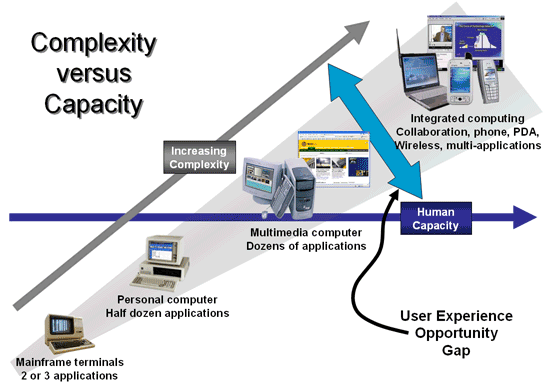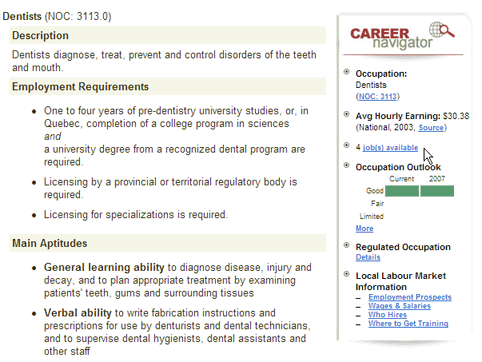on Usability topics and techniques.
We invite you to subscribe
to our monthly e-newsletter.
| September 21, 2006 | Designing usable Web-based applications – One day Workshop. Save $100 if you act now – Register by Sept. 8th. |
| November 30, 2006 | Usability challenges of new Web technologies – One day Workshop. Save $100 if you register by November 17th. |
Upcoming
events
| October 2-4 | AJAXWorld Conference and Expo, Santa Clara, California. |
| October 9-12, 2006 | UIE User Interface 11 conference in Cambridge, Mass. |
| November 14, 2006 | World Usability Day. Come see us at the RA Centre. Participate in the e-Government Showcase in the morning or the Usability Showcase and Trade Show in the afternoon. More details to follow next month. Also, see how to get involved at “Make Yourself Useful“. |
Although there appears to be no end to the rapid developments in technology – with the appearance of more complex computers, applications and services – human capabilities have remained relatively unchanged in terms of perception, memory, and cognitive processing. The trend has to be away from people adapting to technology and towards adapting technology to the needs of the people using it.

As technology matures, products or services based on that technology pass through four generations of product and software differentiation.
- Early adopters : At first, lead users just “have to have” the new technology and are willing to pay almost any price and put up with difficult to use software and systems.
- Price wars: As the technology becomes more pervasive and competition exists, price becomes the next major differentiator.
- Feature fest : Once the cost of development or production has been optimized and competitive pricing has equalized, businesses start to differentiate their products and services by the number of features they can boast – remember the stereo systems of the 70s and 80s with literally hundreds of buttons? Or, what about Microsoft Word 2003 with 19 toolbars and 127 menu items?
- User experience: Feature wars can only take you so far though before people start to realize that there is very little value in having hundreds of features if they can only figure out how to use a very small percentage of them. At this stage, usability and the user experience become the new differentiator.
With the Web, it’s no longer business as usual
The Web has served to make product and service differentiation based on user experience even more important. In the good old days, you only knew about products carried by your local stores. You could comparison shop, but you had to drive all over town and you couldn’t really try out many products until you paid for them and got them home. Once you had made the decision to purchase, you typically persevered and learned how to use the product or software as best you could. Returns were usually only made for defective products – being unusable was not considered to be a defect.
The Web and e-commerce has changed everything. Now people can easily compare Web sites, products, and services from around the world. Products and services are also being marketed differently. Most companies now offer 30-day free trials. In addition, AJAX has accelerated the number of applications and services that can be delivered via the Web and provides new opportunities for improved ease of use, if implemented properly (See last month’s newsletter article on AJAX). These developments change the game across the board.
When people start their buying task, they start by searching and browsing sites to find out what’s available. If your Web site is difficult to find, navigate, or to use, then there are many alternatives. Most users do not have a lot of patience. One US study found that most people using a search engine expect to find what they are looking for on the first page of results.
During the research stage, if people get frustrated trying to find answers to their questions (e.g. pricing) or trying to do comparison shopping they may quickly leave, even before you are aware of a lost visitor or sale.
Before they buy, many companies invite users to “test drive” their products. And, as all of us know, most people expect to be able to complete this “test drive” without training or reading documentation. If not, they rapidly move on.
To simplify the decision process, more and more people are relying on other people’s experiences to help them find the product or software best suited to them. Note the word “experiences”. A perusal of online user feedback, referrals, blogs, etc. quickly shows that more and more of people’s evaluations are based around ease of use, as opposed to features.
User experience design
Delivering competitive products and services as the Web matures and as people’s behaviour becomes more sophisticated requires a design process which directs the focus away from features and functions to the user experience.
User experience design changes the focus from features and functionality to the user experience:
- What do people need?
- What are their goals and expectations?
- What do they know?
- What is the context and environment in which they will be using the product or service?
All these and many more questions are taken into account in designing the user experience. If you look at recent success stories, such as Amazon, NetFlix, or Apple’s iPod, the overwhelming differentiation is the overall user experience, not leading edge technology, prices or features.
In all cases, innovation has come from gaining an understanding of the shortcomings of the current user experience, creating a vision of what the ideal experience could be (we refer to this as the reference experience), and then taking steps to realize that vision and address the unmet and latent needs.
Amazon has revolutionized online book selling by providing recommendations from people who have bought similar books to you, wish lists, rating systems, notifications of new books of interest, one-click purchasing, etc.
NetFlix has grown to be valued at over $1.6 billion in 5 years by providing an innovative way of renting movies. Users create an online list of DVDs they are interested in viewing, DVDs are delivered to your house the next day free of charge, people can view them whenever is convenient (there are no late fees), and returns are made using prepaid envelopes.
Apple’s iPod experience combines the player hardware with iTunes software (available for both Mac and PC) and the iTunes Music Store to create an integrated environment for selecting individual songs, purchasing them, and having them transferred to the player in one seamless operation.
From features to task flows
Many of the innovations we have been involved with over the years have emerged from observing what people do, and why they do what they do, rather than listening to what they say they would do. This distinction is important because it focuses on people’s goals, motivations, and behaviours as opposed to market and public opinion research that puts emphasis on demographics and stated preferences.
Behaviour is not a series of unrelated actions but typically a stream of purposeful activities culminating in some ultimate goal. By focusing on reducing effort and speeding up goal completion we often uncover new insights.
Some work we did with the federal government provides an example. When people were exploring different career options, they often had to visit 3 or more different government Web sites to get answers to questions like: How much does a dentist make? How many jobs are available in that discipline in the Ottawa area? What is the future outlook for employment in this career? Where would I get training?
By linking this information across sites using a standardized code, the National Occupation Code, we were able to provide contextual links to the other relevant information so people did not have to figure out which other Web sites they had to visit, nor navigate through each one to the desired information. The Career Navigator provides these direct, “deep links” to the related information, helping people accomplish their goals much faster.

The Web is exposing more people to more options and also to the difference between usable and non-useable products. Expectations are changing and usable products are clearly the more desirable products. Ease of use is the primary differentiator in the highly competitive market of Web sites and technology products and services. Designing for usability, effectiveness, efficiency, and satisfaction brings with it the added value of repeat business, increased revenues, and best of all free advertising as people share their positive experiences with others.


